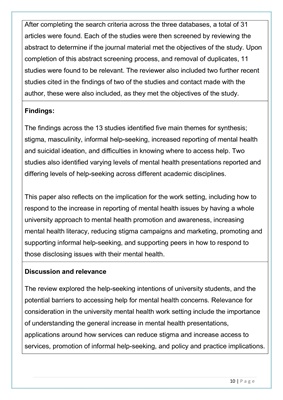
10 | P a g e
After completing the search criteria across the three databases, a total of 31
articles were found. Each of the studies were then screened by reviewing the
abstract to determine if the journal material met the objectives of the study. Upon
completion of this abstract screening process, and removal of duplicates, 11
studies were found to be relevant. The reviewer also included two further recent
studies cited in the findings of two of the studies and contact made with the
author, these were also included, as they met the objectives of the study.
Findings:
The findings across the 13 studies identified five main themes for synthesis;
stigma, masculinity, informal help-seeking, increased reporting of mental health
and suicidal ideation, and difficulties in knowing where to access help. Two
studies also identified varying levels of mental health presentations reported and
differing levels of help-seeking across different academic disciplines.
This paper also reflects on the implication for the work setting, including how to
respond to the increase in reporting of mental health issues by having a whole
university approach to mental health promotion and awareness, increasing
mental health literacy, reducing stigma campaigns and marketing, promoting and
supporting informal help-seeking, and supporting peers in how to respond to
those disclosing issues with their mental health.
Discussion and relevance
The review explored the help-seeking intentions of university students, and the
potential barriers to accessing help for mental health concerns. Relevance for
consideration in the university mental health work setting include the importance
of understanding the general increase in mental health presentations,
applications around how services can reduce stigma and increase access to
services, promotion of informal help-seeking, and policy and practice implications.